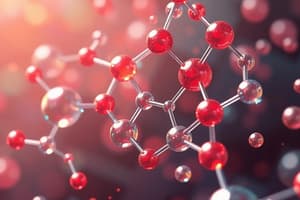Podcast
Questions and Answers
Which industry benefits from using amines as corrosion inhibitors?
Which industry benefits from using amines as corrosion inhibitors?
- Automotive industry
- Food and beverage industry
- Textile industry
- Oil and gas industry (correct)
What role do amines play in water treatment processes?
What role do amines play in water treatment processes?
- Coagulants and flocculants (correct)
- Emulsifiers
- Preservatives
- Colorants
Which industry uses amines in the production of various dyes and pigments?
Which industry uses amines in the production of various dyes and pigments?
- Construction industry
- Fashion industry (correct)
- Food industry
- Healthcare industry
In polymer synthesis, what are amines essential for preparing?
In polymer synthesis, what are amines essential for preparing?
What is the primary application of amines in the oil and gas industry?
What is the primary application of amines in the oil and gas industry?
How do amines contribute to catalysts in organic reactions?
How do amines contribute to catalysts in organic reactions?
What is the role of amines in the pharmaceutical industry?
What is the role of amines in the pharmaceutical industry?
Which type of amines are commonly used as local anesthetics?
Which type of amines are commonly used as local anesthetics?
Why are amines preferred in treating various diseases?
Why are amines preferred in treating various diseases?
What distinguishes tertiary amines from primary amines in terms of structure and classification?
What distinguishes tertiary amines from primary amines in terms of structure and classification?
What makes amines versatile in industrial processes?
What makes amines versatile in industrial processes?
Which category of amines is characterized by having the nitrogen atom not bonded to any hydrogen atoms?
Which category of amines is characterized by having the nitrogen atom not bonded to any hydrogen atoms?
Study Notes
Amines: Versatile Building Blocks in Chemistry and Industry
Amines, a family of organic compounds containing nitrogen with a lone pair of electrons, are a diverse class of molecules with a vast array of applications. They are present in nature, serve as pharmaceuticals, and are integral to many industrial processes. This article will delve into the fascinating world of amines and explore their uses in various fields.
Structure and Classification
Amines are derived from ammonia (NH3) by replacing one or more hydrogen atoms with an alkyl or an aryl group. They are classified according to the number of alkyl or aryl groups they possess:
- Primary amines (1°): One alkyl or aryl group, with the nitrogen atom bonded to a hydrogen atom.
- Secondary amines (2°): Two alkyl or aryl groups, with the nitrogen atom not bonded to any hydrogen atoms.
- Tertiary amines (3°): Three alkyl or aryl groups, with the nitrogen atom not bonded to any hydrogen atoms.
Applications of Amines
Amines take part in a multitude of applications across various sectors, and we will cover some of the most important ones.
Pharmaceuticals
Amines serve as the core structure for numerous pharmaceutical compounds due to their biochemical properties and affinity for biomolecules. Amines are often used to treat various diseases and conditions, including:
- Local anesthetics: Procaine (N-benzylethylamine) and lidocaine (N-(2,6-dimethylphenyl)aminopropanol) are some common examples.
- Antihistamines: Chlorphenamine (N-chloro-2-chloropheniramine) and diphenhydramine (N,N-diethyl-2-amino-3,4-(methylenedioxy)benzeneacetamide) are examples of antihistamines that help alleviate allergy symptoms.
- Beta-blockers: Propranolol (1-(isopropylamino)-3-[1-naphthyl]butanol) is a prominent example, which helps control blood pressure and heart rate.
- Antidepressants: Trimipramine (N-[3-(dimethylamino)propyl]-4-(3-methyl-2-thienyl)morpholine) is an example of an amine-based antidepressant.
Dye and Pigment Manufacturing
Amines are used in the production of various dyes and pigments due to their ability to impart color and stability to products. Amines can act as intermediates, chelating agents, or auxiliaries in the synthesis of dyes and pigments.
Polymer Synthesis
Amines are essential in the preparation of various polymers, such as:
- Polyamides: Nylon 6,6 (hexamethylene diamine + adipic acid) is a prominent example, used for fabrics and engineering applications.
- Polyurethanes: These are synthesized using diisocyanates, which can be formed from amines. Polyurethanes are used in various applications, such as elastomers, foams, and coatings.
Water Treatment
Amines play a vital role in water treatment processes, helping remove various contaminants and improving water quality. For instance, they are used as coagulants and flocculants in the removal of heavy metals, organic pollutants, and suspended solids.
Corrosion Inhibition
Amines are used as corrosion inhibitors in various industrial processes, especially in the oil and gas industry. They adsorb onto metal surfaces, forming a protective layer and preventing metal corrosion.
Catalysts
Amines can act as catalysts in organic reactions, such as the Strecker synthesis, the hydrogenation of alkenes, and the enantioselective aldol condensation. They can also be used as phase-transfer catalysts in various organic reactions.
In conclusion, amines are versatile organic compounds with numerous applications across various industries and sectors. Their unique properties and diverse structures have enabled them to serve as essential building blocks in pharmaceuticals, polymers, water treatment processes, corrosion inhibition, and catalysis. As such, amines continue to play a vital role in addressing global challenges in areas like health care, environmental sustainability, and industrial processes.
Studying That Suits You
Use AI to generate personalized quizzes and flashcards to suit your learning preferences.
Description
Test your knowledge on amines, a diverse class of organic compounds with wide-ranging applications in pharmaceuticals, dye manufacturing, polymer synthesis, water treatment, corrosion inhibition, and catalysis. Explore the structure, classification, and various uses of amines across different industries.




